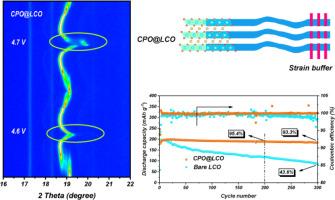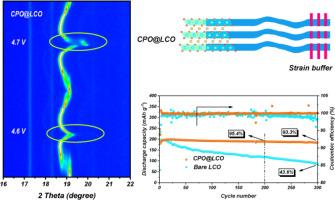在LiCoO2上构建晶格匹配应变缓冲层用于稳定高压循环
IF 20.2
1区 材料科学
Q1 CHEMISTRY, PHYSICAL
引用次数: 0
摘要
锂钴氧化物(LCO)由于其高体积能量密度,特别是在高达4.7 V的高截止电压下,受到了相当大的关注。然而,高压LCO较差的循环稳定性限制了其实际应用,主要是由于4.55 V以上的不利相变、深度衰减时的氧损失以及界面副反应。在本研究中,我们通过CePO4涂层在LCO颗粒上引入原位形成的应变缓冲层,以提高其高压性能。包覆的CePO4层与LCO粒子自发反应生成晶格匹配的Li8CeO6相,有利于Li+的迁移,减轻近表面本质应力。在晶格应变较小的情况下,不良的相变和严重的表面退化被显著抑制。此外,Ce- 4f键和o2p键的强共价以及Ce- o6八面体构型中的离域电子有助于抑制4.6 V下的氧氧化还原。在4.6 V电压下,300次循环后容量保持率为93.3%,在4.7 V电压下100次循环后容量保持率为88%。这种在颗粒表面附近构建应变缓冲层的策略为稳定高压LCO提供了新的见解,并为其他阴极材料的进一步改性铺平了道路。本文章由计算机程序翻译,如有差异,请以英文原文为准。


Constructing lattice-matched strain buffer layer on LiCoO2 for stable high-voltage cycling
Lithium cobalt oxide (LCO) has received considerable attention due to its high volumetric energy density, particularly at elevated cut-off voltages up to 4.7 V. However, the poor cyclic stability of high-voltage LCO limits its practical application, primarily due to detrimental phase transitions above 4.55 V, oxygen loss upon deep delithiation, and the interfacial side reactions. In this study, we introduce an in-situ formed strain buffer layer on LCO particles by CePO4 coating to improve its high-voltage performance. The coated CePO4 layer reacts with LCO particles spontaneously to generate a lattice-matched Li8CeO6 phase, which can facilitate Li+ transportation and relieve near-surface intrinsic stress. With less lattice strain, the undesirable phase transition and notorious surface degradation are suppressed significantly. Moreover, strong covalence of Ce 4f and O 2p bonds, and delocalized electrons in Ce-O6 octahedral configuration help to suppress oxygen redox at 4.6 V. A high capacity retention of 93.3% after 300 cycles at 4.6 V and 88% after 100 cycles at 4.7 V is harvested. This strategy of constructing a strain buffer layer near the particle surface provides a novel insight for stabilizing the high-voltage LCO and paves the way for further modification of other cathode materials.
求助全文
通过发布文献求助,成功后即可免费获取论文全文。
去求助
来源期刊

Energy Storage Materials
Materials Science-General Materials Science
CiteScore
33.00
自引率
5.90%
发文量
652
审稿时长
27 days
期刊介绍:
Energy Storage Materials is a global interdisciplinary journal dedicated to sharing scientific and technological advancements in materials and devices for advanced energy storage and related energy conversion, such as in metal-O2 batteries. The journal features comprehensive research articles, including full papers and short communications, as well as authoritative feature articles and reviews by leading experts in the field.
Energy Storage Materials covers a wide range of topics, including the synthesis, fabrication, structure, properties, performance, and technological applications of energy storage materials. Additionally, the journal explores strategies, policies, and developments in the field of energy storage materials and devices for sustainable energy.
Published papers are selected based on their scientific and technological significance, their ability to provide valuable new knowledge, and their relevance to the international research community.
 求助内容:
求助内容: 应助结果提醒方式:
应助结果提醒方式:


